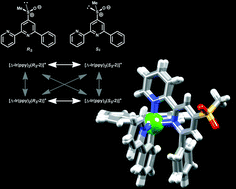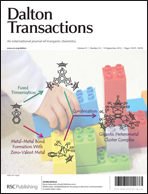Abstract
The ligands 4-methylthio-6-phenyl-2,2′-bipyridine (1) and the corresponding sulfoxide (2) and sulfone (3) have been synthesized and characterized in solution, and in the solid state by single crystal X-ray diffraction. Compounds 2 and 3 crystallize in the same space group (C2/c) with similar unit cell parameters; a small increase in the unit cell volume allows for the presence of the extra oxygen atom in 3. The sulfoxide and sulfone groups adopt conformations that permit intramolecular O⋯HCaryl hydrogen bonds. The complexes [Ir(ppy)2L][PF6] with L = 1, 2 or 3 have been prepared and characterized. The asymmetric sulfur atom in ligand 2 gives rise to pairs of diastereoisomers of the complex which can be distinguished in the 1H and 13C NMR spectra. In solution, exchange of [PF6]− by [Δ-TRISPHAT]− gives rise to four diastereoisomers and we observed good dispersion of 1H NMR resonances, especially for those assigned to protons close to the asymmetric sulfur atom. A single crystal X-ray diffraction study of 2{[Ir(ppy)2(3)][PF6]}·CHCl3·3H2O reveals that the complex crystallizes in the chiral space group P212121, the asymmetric unit containing crystallographically independent Δ- and Λ-[Ir(ppy)2(3)]+ cations. This provides a rare example of a so-called kryptoracemate in the solid state. In MeCN solution, [Ir(ppy)2(1)][PF6], [Ir(ppy)2(2)][PF6] and [Ir(ppy)2(3)][PF6] are weakly emissive (λem = 600, 647 and 672 nm, respectively) and preliminary studies of the electroluminescent properties of [Ir(ppy)2(2)][PF6] indicate that the complexes are not suitable candidates for LECs.

- This article is part of the themed collection: In Celebration of David Cole-Hamilton's Career in Chemistry

 Please wait while we load your content...
Please wait while we load your content...